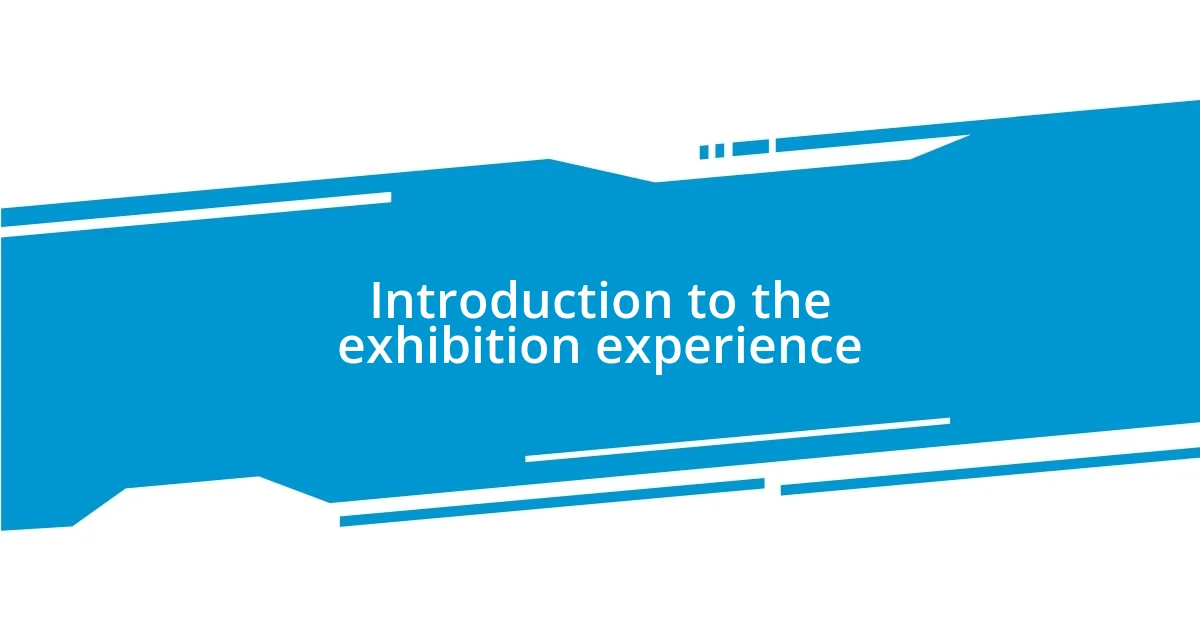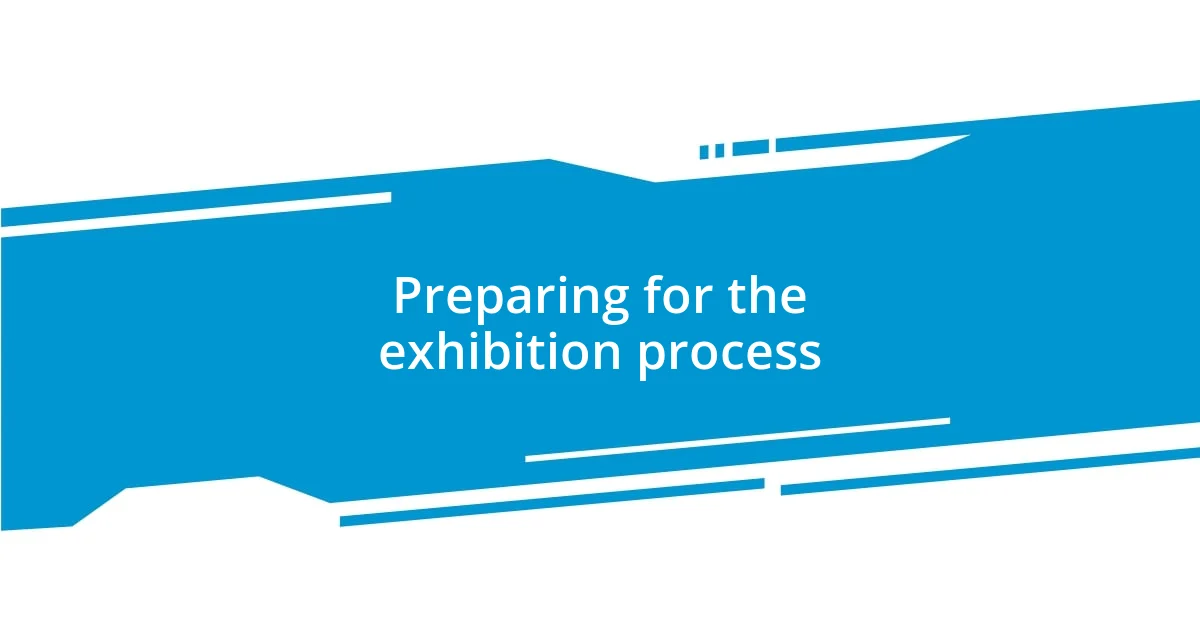Key takeaways:
- Engaging with local artists and fostering collaboration enhances the exhibition’s creativity and emotional impact.
- Creating a well-structured timeline is crucial for organized planning and allows for meaningful engagement throughout the process.
- Effective marketing, including community partnerships and interactive events, builds anticipation and enhances attendance.

Introduction to the exhibition experience
Coordinating a local exhibition is truly a unique blend of excitement and challenge. From the moment I stepped into the planning phase, I felt a rush of anticipation—like flipping through the pages of a new book, eager to see where the story would take me. Have you ever experienced the thrill of bringing diverse artistic voices together under one roof? It’s both exhilarating and daunting.
As I rolled up my sleeves, diving into logistics, I discovered how deeply this process connects us to our community. One particular moment stands out: I found myself chatting with a local artist who shared her passion about her work. Her enthusiasm was contagious and reminded me why I loved this gig—art has a way of weaving stories and bridging gaps, doesn’t it? I realized that the heart of the exhibition wasn’t just about showcasing art; it was about creating connections between the artists and the audience.
Every detail mattered, from choosing the right venue to curating the artwork, each decision wrapped in excitement and nerves. I remember obsessively arranging the pieces, striving for a cohesive narrative. It felt like preparing for a big dinner party, where every dish needed to complement the other. Have you ever put together something so meaningful that you could almost feel the energy in the room? That’s where I found my motivation—knowing that this exhibition would spark conversations, inspire creativity, and foster a love for the arts.

Preparing for the exhibition process
Preparing for an exhibition is a multifaceted experience, filled with both logistical considerations and emotional undercurrents. I distinctly remember sifting through a mountain of tasks on my checklist. Each item was tied to a memory or an interaction that brought the entire exhibition to life. It’s fascinating how organizing an event can be a reflection of one’s identity and passion for the arts.
Here are a few key steps I took to make the preparation process smoother:
- Set Clear Objectives: Understand what you want to achieve, whether it’s showcasing talent, promoting local art, or engaging the community.
- Budget Wisely: Allocate funds thoughtfully, considering everything from venue rental to promotional materials.
- Choose the Right Venue: The space sets the tone; I learned that ambiance plays a crucial role in how artwork is perceived.
- Coordinate with Artists: Constant communication fosters trust and excitement, which I found vital to the process.
- Promote Early: Getting the word out well in advance helps build anticipation; I utilized social media and local press to create buzz.
- Prepare for Day-of Logistics: Arranging for setup, signage, and equipment needs can make or break the experience, so I always had a checklist handy.
I still chuckle at the memory of the early morning setup, surrounded by canvases and excited chatter. The energy was palpable, like the stillness before a concert that’s about to start.

Engaging with local artists
Engaging with local artists during the exhibition planning process was a real highlight for me. I remember reaching out to a talented painter who used vibrant colors to express her emotions. One afternoon, we met for coffee and she opened up about her artistic journey, which was both inspiring and eye-opening. Listening to her stories made me realize how vital it is to create a space where these unique voices can shine.
Connecting with the artists involved more than just logistics; it was about building relationships. I arranged several informal meetings, where we shared ideas and collaborated on concepts for the exhibition. One evening, while reviewing artwork, an amusing debate erupted over the thematic arrangement. Our laughter filled the room and reminded me that art isn’t just about the final product—it’s about the joy of creation and interaction.
The excitement of working closely with local talent fueled my passion like I had never experienced before. One moment stands out: I invited several artists to a brainstorming session, where we generated ideas for interactive installations. Seeing their eyes light up at the possibility of engaging the audience was a reminder of why I love this work. It’s in those moments of collaboration and shared enthusiasm that the true spirit of the exhibition emerged.
| Engagement Activity | Impact |
|---|---|
| Coffee Chats with Artists | Builds personal connections and trust. |
| Informal Meetings | Fosters collaboration and idea-sharing. |
| Brainstorming Sessions | Encourages creativity and participatory art. |

Creating an exhibition timeline
Creating an exhibition timeline is one of the most critical aspects of the planning process. I found that breaking down the timeline into specific phases really helped me stay organized. For instance, I set milestones for when I needed to finalize the venue, when to send invites to artists, and when to launch my marketing campaign. This structure acted as my anchor, helping me navigate through the chaos of preparations.
As I crafted this timeline, I couldn’t help but wonder—how much time is truly needed for each step? In my experience, granting each phase ample time pays off significantly. I remember allocating a full month just for artist coordination, which allowed for ample communication and creativity to flow. This also ensured that no detail was overlooked; everything from artwork transportation to setup was meticulously planned.
Putting together a timeline can feel daunting, but I discovered that it’s also exciting. The anticipation of each milestone coming to life is what kept my motivation high. I vividly recall the thrill when I ticked off “Promotional Materials Created” from my checklist; it felt like a small victory! Ultimately, a well-structured timeline not only keeps you on track but also allows you to engage meaningfully with each aspect of the exhibition. How do you celebrate those small wins during a planning process? For me, it’s a simple high-five with my team—or even just taking a moment to enjoy a cup of coffee while reflecting on how far we’ve come.

Marketing the exhibition effectively
Effective marketing is essential for any exhibition, and I’ve learned that tapping into the local community can make a huge difference. I remember attending a community meeting where I shared our exhibition’s vision. Engaging with local businesses and organizations wasn’t just a box to check; it genuinely felt like a partnership. They often have vast networks that can amplify our reach, making the collective investment worthwhile.
Social media also played a key role. I crafted a series of posts highlighting behind-the-scenes moments, like sneak peeks of artwork and artist profiles. One post went viral, thanks to an artist’s enthusiastic sharing. It was a game changer for our attendance numbers! Have you ever experienced the thrill of a post taking off? It creates a sense of connection that transcends the gallery walls.
Lastly, I discovered the power of hands-on, interactive marketing. I organized pop-up events leading up to the exhibition where people could create DIY art pieces. Watching families come together and engage with art in a fun way was a joy. It not only raised awareness but also created excitement among potential attendees. Isn’t it fascinating how these personal connections foster a sense of ownership and anticipation for an event? Each step of marketing felt not just like a strategy, but an essential part of building a community around the exhibition experience.

Evaluating the exhibition outcome
Evaluating the outcome of the exhibition is a process that feels both revealing and reflective. After the event concluded, I gathered feedback from attendees and artists alike, which provided a wealth of insights I never anticipated. More than just numbers on a spreadsheet, these comments gave me a glimpse into the emotional impact the exhibition had on people. Was there a specific piece that struck a chord with visitors? Learning about those connections was nothing short of inspiring.
I found it essential to assess both qualitative and quantitative data. The attendance numbers were promising, but what I cherished more were the heartfelt conversations I had with guests. I remember one lady telling me how an artwork had stirred memories of her childhood. It reinforced my belief that exhibitions should not just showcase art but create meaningful interactions. Can you recall an experience where art resonated deeply with you? Those moments are what I strive to capture in every curatorial effort.
Moreover, I reflected on the logistics and planning phases that went into the exhibition’s execution. During our post-event analysis, I noted areas where we could improve—like ensuring better signage throughout the space for clearer navigation. These takeaways are vital for my growth as an organizer. It’s all about evolving, right? I now view evaluating the outcome not just as a task but as a critical learning opportunity that fuels my passion for future projects.
















